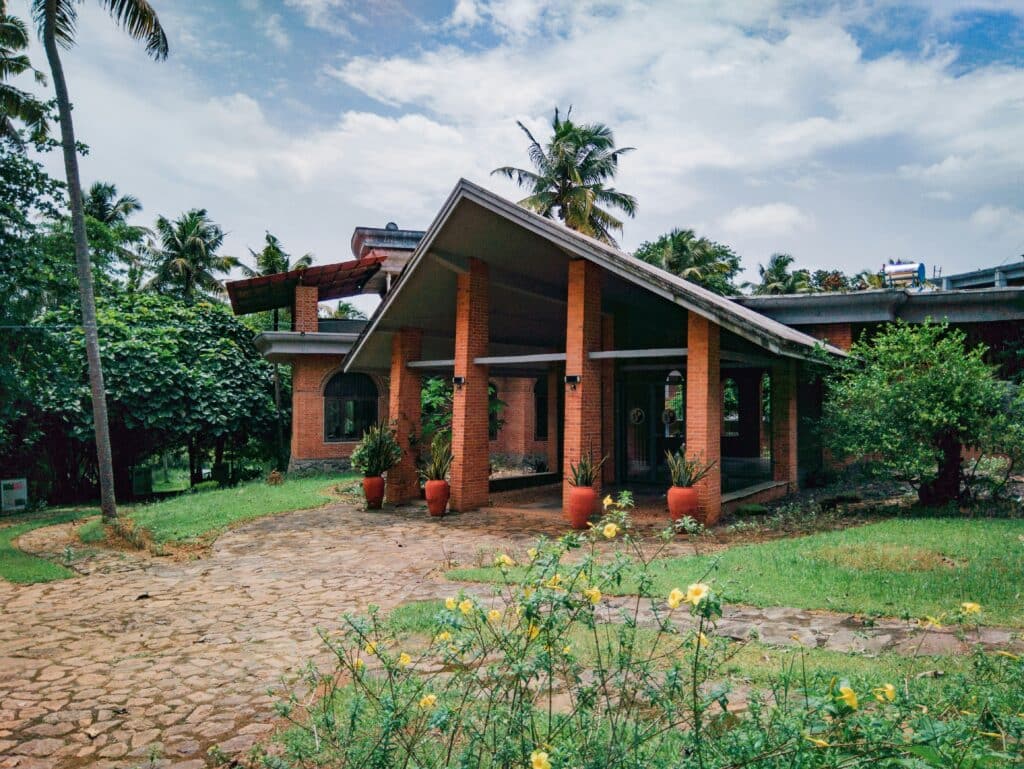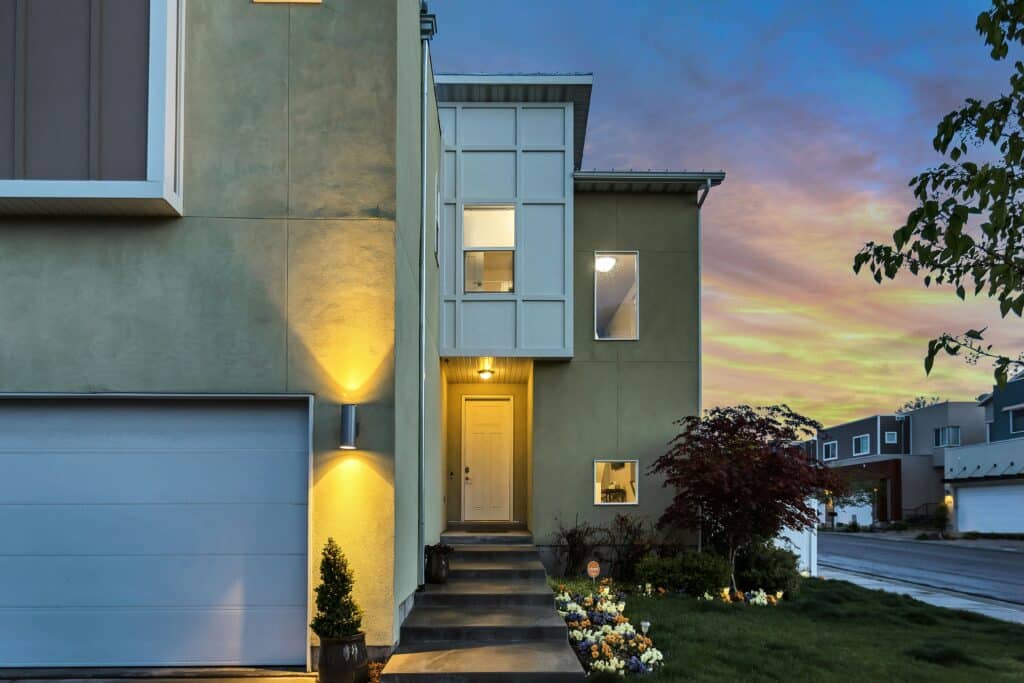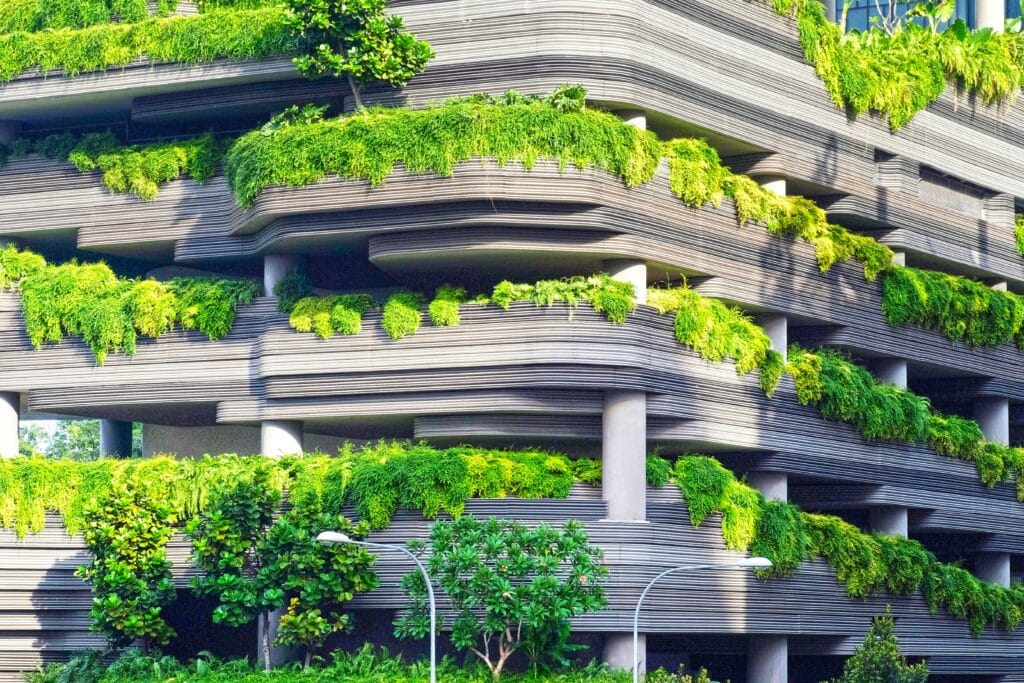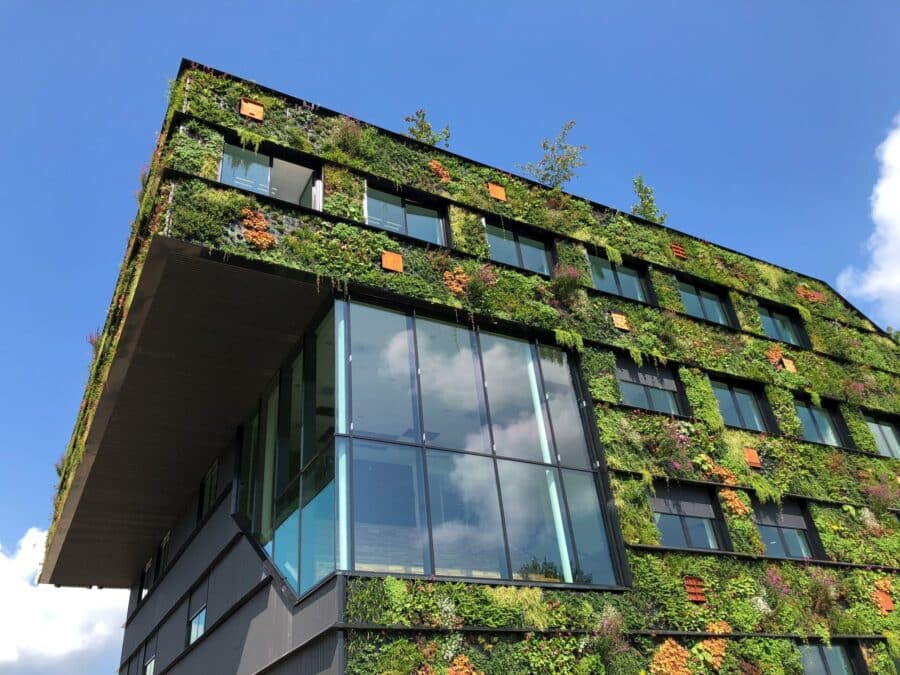Las tendencias de la arquitectura para 2024 vienen pisando fuerte y están destinadas a entusiasmarte con el futuro. En particular, la sostenibilidad en la arquitectura sigue configurando el futuro del diseño.
Lo vemos a través de la integración de tecnologías de vanguardia como el modelado paramétrico, la impresión 3D y los materiales sostenibles para crear estructuras que no sólo satisfagan las necesidades actuales, sino que también mitiguen el impacto medioambiental para las generaciones venideras.
Podemos afirmar con certeza que la sostenibilidad ha dejado de ser una ocurrencia tardía a la hora de diseñar, y ahora es una consideración fundamental en todas las fases del proceso arquitectónico. Juntas, la innovación y la sostenibilidad no sólo están redefiniendo el aspecto de la arquitectura, sino que también están allanando el camino para una relación más armoniosa entre la población humana y nuestro planeta.
Si esto suena como música para tus oídos, sigue desplazándote para descubrir todos los mejores 2024 diseño arquitectónico tendencias.
Diseños sostenibles y ecológicos
Los diseños sostenibles y ecológicos dan prioridad a la responsabilidad medioambiental y a la eficiencia de los recursos en la arquitectura. Estos diseños minimizan intencionadamente los impactos negativos sobre el planeta, al tiempo que promueven entornos interiores más saludables y la resiliencia de las comunidades. A medida que aumenta la urgencia del cambio climático, el diseño sostenible se hace esencial para un futuro más verde, así que repasemos algunas de las principales formas en que lo estamos viendo en la arquitectura.
Integración de materiales ecológicos
Los arquitectos innovadores incorporan cada vez más materiales ecológicos a sus diseños. Esto incluye acero reciclado, madera recuperada, bambú, corcho y plásticos reciclados. Al dar prioridad a estos materiales ecológicos, los arquitectos no sólo reducen el agotamiento de los recursos, sino que también mitigan la contaminación y la generación de residuos a lo largo del proceso de construcción.
Implantación de tecnologías energéticamente eficientes
El uso de tecnología energéticamente eficiente es el núcleo de la arquitectura sostenible. Desde estrategias de diseño pasivo como la orientación y la ventilación natural hasta sistemas avanzados como paneles solares, calefacción geotérmica y automatización inteligente de edificios, los arquitectos utilizan diversas tecnologías para minimizar el consumo de energía y la dependencia de los combustibles fósiles. En conjunto, esto reduce en última instancia las emisiones de carbono y los costes operativos para los propietarios de los edificios.
Adoptar prácticas de construcción ecológicas
Los arquitectos comprometidos con la sostenibilidad adoptan cada vez más prácticas de construcción ecológica, como la certificación LEED (Liderazgo en Energía y Diseño Medioambiental) y los principios del diseño biofílico. Estas prácticas dan prioridad a estrategias como la optimización del uso del emplazamiento, la conservación de los hábitats naturales y el fomento del bienestar de los ocupantes mediante el acceso a la luz natural, las vistas de la naturaleza y las mejoras de la calidad del aire interior, fomentando entornos que nutran tanto a las personas como al planeta.
Ejemplos de proyectos arquitectónicos sostenibles
Para que te hagas una idea de cómo los arquitectos están haciendo sus diseños más sostenibles y ecológicos, repasaremos algunos ejemplos.
El Edge de Ámsterdam, conocido como el edificio de oficinas más sostenible del mundo, incorpora elementos innovadores como paneles solares, iluminación LED de bajo consumo y un sistema inteligente que ajusta el clima y la iluminación en función de la ocupación.
El Centro Bullitt de Seattle es todo sostenibilidad, ya que cubre sus necesidades energéticas totalmente con fuentes renovables. Este edificio también utiliza inodoros de compostaje y recogida de agua de lluvia.
Ambos proyectos demuestran que la arquitectura sostenible no es sólo un concepto teórico, sino una realidad tangible que está dando forma al futuro de nuestro entorno.

Reutilización adaptativa y renovación
La reutilización adaptativa y la renovación redefinen las prácticas arquitectónicas transformando las estructuras existentes en espacios vibrantes y sostenibles. Con este planteamiento, los arquitectos pueden insuflar nueva vida a edificios antiguos, asegurándose de que conservan importantes detalles patrimoniales al tiempo que satisfacen las necesidades modernas. Esto también ayuda a reducir los residuos y el impacto medioambiental, uniendo pasado y presente de la mejor manera posible. He aquí algunas de las formas en que los arquitectos lo están consiguiendo:
Destacar la importancia de la reutilización adaptativa
Con una sostenibilidad cada vez más popular, la importancia de la reutilización adaptativa para los arquitectos sigue creciendo. Con espacio y recursos limitados, la reutilización de estructuras existentes ofrece una solución sostenible para satisfacer las necesidades cambiantes, preservando al mismo tiempo el patrimonio cultural. Los arquitectos a los que se encomiendan proyectos de reutilización adaptativa se enfrentan al reto de reimaginar espacios, mezclando la historia con la funcionalidad moderna.
Reutilización de estructuras existentes para la sostenibilidad
Es probable que hayas visto esta idea en acción en tu propio barrio. Con esta idea, los arquitectos renuevan edificios antiguos para minimizar el impacto medioambiental, preservar los recursos y fomentar la revitalización de la comunidad. Este planteamiento reduce los residuos y el consumo de energía al tiempo que honra el patrimonio cultural.
Preservar el significado cultural e histórico
Como ya hemos dicho, al plantearse la renovación de lugares históricos, los arquitectos no se limitan a derribar edificios y diseñar otros nuevos y modernos. En lugar de ello, se tiene muy en cuenta la conservación de la importancia cultural e histórica del edificio antes de realizar ningún cambio. De hecho, la conservación del significado cultural e histórico es un aspecto fundamental de la práctica arquitectónica.
Los arquitectos identifican, documentan y conservan estructuras de importancia cultural e histórica. Lo hacen mediante una investigación meticulosa, una restauración sensible y una reutilización adaptativa, que ayudan a mantener la autenticidad y la integridad de estos lugares al tiempo que permiten su uso y disfrute continuos por parte de las comunidades.
Ejemplos notables de proyectos de reutilización adaptativa con éxito
El High Line de Nueva York es un excelente ejemplo de proyecto de reutilización adaptativa con éxito. En este escenario, un ferrocarril elevado abandonado se transformó en un vibrante parque público, mezclando a la perfección la naturaleza con la infraestructura urbana.
Otro proyecto notable es la Tate Modern de Londres, antaño una central eléctrica en desuso, ahora un museo de arte contemporáneo de fama mundial, que muestra la armoniosa integración del patrimonio industrial con la revitalización cultural.
Más cerca de la naturaleza, el Proyecto Edén de Cornualles reconvirtió un pozo abandonado de arcilla china en un extenso jardín botánico y centro educativo, demostrando cómo la arquitectura puede coexistir armoniosamente con el medio ambiente.
Estos proyectos no sólo insuflan nueva vida a espacios olvidados, sino que también sirven como modelos inspiradores de renovación urbana sostenible y compromiso comunitario.

Arquitectura inteligente y receptiva
La arquitectura inteligente y receptiva revoluciona el diseño de los edificios integrando tecnologías de vanguardia para optimizar el confort, la eficiencia y la sostenibilidad. Implica estructuras que se adaptan dinámicamente a las condiciones cambiantes y a las preferencias de los usuarios en tiempo real, prometiendo un futuro en el que los edificios sean intuitivos y estén profundamente en sintonía con su entorno y sus ocupantes. Profundicemos un poco más en algunas de las formas en que los arquitectos están utilizando la arquitectura inteligente y receptiva:
Integración de tecnologías inteligentes en el diseño
La integración de tecnologías inteligentes en el diseño representa una evolución significativa en la arquitectura, donde los edificios se convierten en algo más que estructuras estáticas, sino en entidades dinámicas. Al incorporar sensores, análisis de datos y sistemas de automatización, los arquitectos pueden crear espacios que se adapten inteligentemente a las condiciones ambientales, el comportamiento de los usuarios y las demandas energéticas.
Juntas, estas tecnologías aumentan el confort, la eficiencia y la sostenibilidad, lo que no sólo mejora la funcionalidad general de los edificios, sino que también fomenta una experiencia más interactiva y personalizada para los ocupantes.
Edificios receptivos que se adaptan a las condiciones ambientales
Los edificios receptivos que se adaptan a las condiciones ambientales ayudan a mostrar la relación entre arquitectura y naturaleza, donde las estructuras interactúan a la perfección con su entorno para optimizar el rendimiento y la sostenibilidad. Mediante estrategias de diseño innovadoras, como la calefacción solar pasiva, los sistemas de ventilación natural y los elementos de sombreado dinámico, los arquitectos crean edificios que responden intuitivamente a los cambios de las pautas meteorológicas, los niveles de luz natural y la calidad del aire.
Estas características sensibles no sólo mejoran el confort de los ocupantes, sino que también reducen el consumo de energía y las emisiones de carbono. Al armonizar con el entorno natural, estos edificios ejemplifican un enfoque holístico de la arquitectura.
Utilización de sistemas automatizados de climatización y seguridad
La utilización de sistemas automatizados de climatización y seguridad representa la cúspide de la innovación arquitectónica moderna, ya que mejora tanto el confort como la seguridad dentro de los edificios. Mediante sofisticados sensores y algoritmos, los arquitectos pueden diseñar edificios que regulen de forma inteligente la temperatura, la humedad y la calidad del aire. Además, los sistemas de seguridad automatizados proporcionan supervisión y respuesta en tiempo real a posibles amenazas, reforzando la seguridad y la tranquilidad.
Al integrar estas tecnologías a la perfección en el diseño del edificio, los arquitectos no sólo elevan la experiencia del usuario, sino que también contribuyen a una mayor eficiencia, sostenibilidad y resistencia dentro del propio edificio.
Ejemplos que muestran la unión entre tecnología y arquitectura
Un ejemplo notable es el Marina Bay Sands de Singapur, que cuenta con una impresionante piscina infinita en la azotea sostenida por avanzados sistemas hidráulicos y de ingeniería estructural.
Otra es la Escuela Internacional de Copenhague, donde una fachada de paneles solares aprovecha la energía renovable a la vez que sirve de sistema de sombreado dinámico.
Además, el Edge de Ámsterdam destaca por su integración de sensores inteligentes y análisis de datos para crear un lugar de trabajo energéticamente eficiente y centrado en el usuario.
Estos ejemplos demuestran cómo la tecnología puede mejorar a la perfección la funcionalidad, la sostenibilidad y la estética, ampliando los límites del diseño arquitectónico.

Diseño biofílico
El diseño biofílico integra la naturaleza en la arquitectura para mejorar el bienestar y la sostenibilidad. Al incorporar elementos como la luz natural y la vegetación, fomenta la calma, la productividad y la conexión con el entorno. Este enfoque crea espacios más saludables y armoniosos que benefician tanto a los ocupantes como al planeta. Veamos algunos de los componentes clave del diseño biofílico:
Definición y significado del diseño biofílico
El diseño biofílico representa un enfoque holístico de la arquitectura y el urbanismo, que reconoce los profundos beneficios psicológicos y fisiológicos de conectar a las personas con la naturaleza. Hace hincapié en la integración de elementos, pautas y procesos naturales en los espacios arquitectónicos para mejorar el bienestar humano y aumentar la calidad de vida en general.
Al fomentar una sensación de armonía y conexión con el mundo natural, el diseño biofílico trata de contrarrestar los efectos negativos de la urbanización, como el estrés, la ansiedad y la alienación, al tiempo que fomenta la salud, la productividad y la creatividad.
Incorporación de la Naturaleza al Entorno Construido
La incorporación de la naturaleza al entorno construido abarca una amplia gama de estrategias y técnicas de diseño destinadas a simular o evocar experiencias naturales dentro de los espacios arquitectónicos. Esto puede incluir maximizar el acceso a la luz natural mediante grandes ventanales y claraboyas, integrar vegetación interior como paredes vivas y plantas en macetas, incorporar elementos acuáticos como fuentes o estanques, y utilizar materiales naturales como madera, piedra y acabados basados en la tierra. Además, el diseño biofílico suele incorporar formas y patrones biomórficos inspirados en la naturaleza, como geometrías fractales y formas orgánicas.
Beneficios del diseño biofílico para el bienestar
La investigación sobre los efectos del diseño biofílico en el bienestar humano ha mostrado sistemáticamente resultados positivos. La exposición a elementos naturales en la arquitectura se ha relacionado con la reducción de los niveles de estrés, la mejora del estado de ánimo y la función cognitiva, la mejora de la creatividad y la productividad, y el aumento de la satisfacción general con los espacios interiores.
Al crear entornos que imitan las cualidades reparadoras de la naturaleza, el diseño biofílico favorece la salud mental y física, reduce el absentismo y la rotación en los lugares de trabajo, y fomenta un mayor sentido de conexión y pertenencia entre los ocupantes.
Proyectos arquitectónicos notables que adoptan principios biofílicos
Numerosos proyectos arquitectónicos de todo el mundo son ejemplos de principios de diseño biofílico en acción. Por ejemplo, la Academia de Ciencias de California, en San Francisco, presenta un tejado vivo cubierto de vegetación autóctona, que proporciona hábitat a la fauna local y reduce el consumo de energía mediante el aislamiento natural. El aeropuerto Changi de Singapur cuenta con la Joya, un jardín interior de varios pisos y un complejo de cascadas que ofrece a los viajeros un respiro tranquilo en medio del bullicioso entorno aeroportuario.
¿Cómo incorporarás estas tendencias arquitectónicas de 2024 a tu diseño?
En resumen, las tendencias arquitectónicas de 2024 reflejan un cambio hacia la sostenibilidad, la adaptabilidad y el diseño centrado en el ser humano. Las prácticas sostenibles y ecológicas, la reutilización adaptativa, la tecnología inteligente y el diseño biofílico se han convertido en características destacadas de la arquitectura contemporánea. arquitecturay estamos impacientes por ver adónde nos llevan en el futuro.
Juntas, estas tendencias han tenido un impacto positivo en el entorno construido al reducir la huella medioambiental, preservar el patrimonio cultural, mejorar la comodidad de los ocupantes y fomentar el bienestar.
De cara al futuro, se prevén más innovaciones, impulsadas por los avances tecnológicos y la colaboración interdisciplinar. Los arquitectos tienen una oportunidad única de seguir dando forma a un futuro más sostenible, resistente e integrador mediante intervenciones creativas de diseño.
¿Cómo vas a contribuir?












